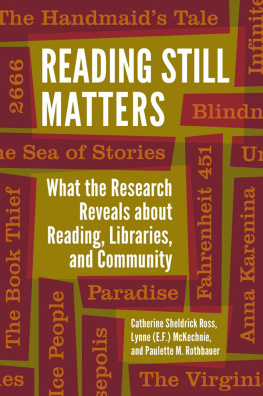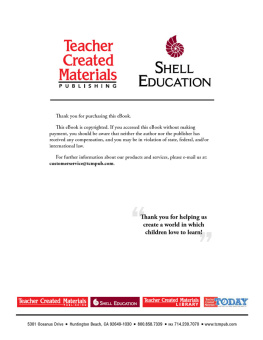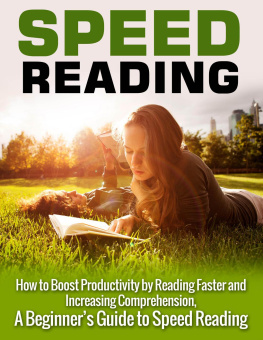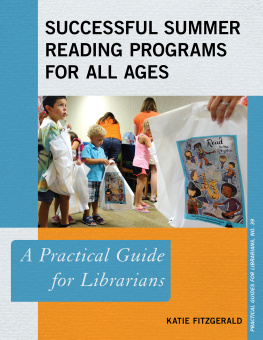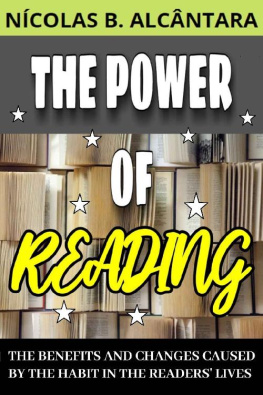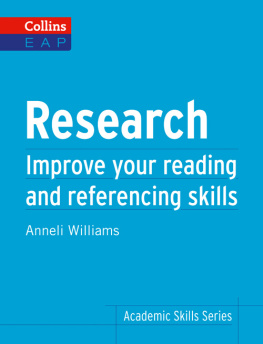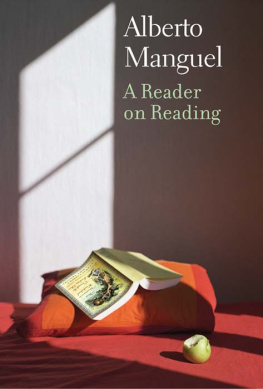The Pleasures of Reading
A Booklovers Alphabet
Catherine Sheldrick Ross

Copyright 2014 by Catherine Sheldrick Ross
All rights reserved. No part of this publication may be reproduced, stored in a retrieval system, or transmitted, in any form or by any means, electronic, mechanical, photocopying, recording, or otherwise, except for the inclusion of brief quotations in a review, without prior permission in writing from the publisher.
Library of Congress Cataloging-in-Publication Data
Ross, Catherine Sheldrick.
The pleasures of reading : a booklovers alphabet / Catherine Ross.
pages cm
Includes bibliographical references and index.
ISBN 9781591586951 (paperback) ISBN 9781610694339 (ebook) 1. Books and reading. 2. Reading interests. 3. ReadingSocial aspects. 4. Popular literature. 5. Public services (Libraries) 6. Libraries and community. I. Title.
Z1003.R74 2014
028.9dc23 2014008161
ISBN: 9781591586951
EISBN: 9781610694339
18 17 16 15 14 1 2 3 4 5
This book is also available on the World Wide Web as an eBook.
Visit www.abc-clio.com for details.
Libraries Unlimited
An Imprint of ABC-CLIO, LLC
ABC-CLIO, LLC
130 Cremona Drive, P.O. Box 1911
Santa Barbara, California 93116-1911
This book is printed on acid-free paper 
Manufactured in the United States of America
Contents
Acknowledgments
Thanks are owing to a great many people, not least of which are the 302 avid readers whose talk about their reading experiences is a core element of this book. I am equally indebted to the 276 interviewers in successive offerings of my graduate course on genres of fiction and reading, who recruited the avid readers, interviewed them, and transcribed the interviews (see QUESTIONS ABOUT READING). I would especially like to thank Kim Kofmel, who made available for my use her 32 interviews with avid readers from her science fiction, fantasy, and horror study. The research program of interviewing readers was supported in part by a grant from the Social Sciences and Humanities Research Council of Canada (SSHRC). Thanks also to these reading experts who have made suggestions, read sections of this book, provided helpful suggestions and examples, or agreed to be interviewed: Mary K. Chelton, Delilah Dean Cummings, Keren Dali, Simon Davies, Rosemary Lewis, Lynne McKechnie, Cindy Orr, Nancy Pearl, Jen Pecoskie, Paulette Rothbauer, Jake Ross, Sarah Ross, Joyce Saricks, Nancy Schiefer, Lucia Cedeira Serantes, Nancy Tausky, Ase Kristine Tweit, Elizabeth Waterston, and Neal Wyatt. And finally, as always, thanks are due to my editor Barbara Ittner, who got me started on this ABC project over coffee at an American Library Association Conference and has waited so patiently for its completion.
Introduction: 30 Ways of Looking at the Reading Experience
At the very heart of this book is the reader who reads for pleasure. Imagine a circle with the reader at the center. Around the circumference of the circle, visualize as nodes all those interrelated agents, processes, and activities geared to bringing about a happy encounter of reader and book. What are some of these nodes? There are the authors, who write manuscripts within the conventions of their chosen genre, whether epic poem, literary fiction, a vampire story, or a self-help book. There are the publishers and editors, who choose, shape, package, and publicize the books they publish. Intermediaries write the reviews and award the prizes that attract readers attention to particular titles. Librarians and booksellers are agents of distribution as they order, display, and recommend particular books to readers. Changing technologies affect every phase of book production, distribution, and consumption from the composition of the manuscript to the reading of the book, now happening increasingly on-screen. And, crucially, there are the hidden structures, from the neurons in the brain to the literacy practices of schools and families, that are preconditions for the reader to be able to make sense of the black marks on page or screen. In this book, I offer 30 ways of looking at the experience of reading. The reader is the hero of this story, with the various entries exploring the relation between the reader and one or more of these other nodes. In the end, everything is connected.
The first entry, ABC AND COUNTING BOOKS, tips my hand about my attraction to alphabetic organizationits arbitrariness, inclusiveness, circularity, and intimate connection with the processes of reading itself. While I was trying to write this introduction, I answered a phone call from my daughter, who invited my 23-month-old grandson Cormac to sing the ABC song. He started out strongly, faltered and trailed away in the middle, and rallied at the closeABCDEFG mumble, mumble, mumble/Now I know my ABCs/Wont you sing along with me. Beginning readers all start their journey into literacy with the ABCs. Eventually, reading, whenever it is pleasurable, seems automatic and effortless. Its only when the invisible and taken-for-granted brain processes involved in reading break down that they come to our attention, as happens in the case study of the man who forgot how to read (see ALEXIA). You can start reading this book with the A entries, but you dont have to. You can start anywhere and end anywhere, pursuing your interests and skipping from one entry to another by following the cross-references formatted in small caps.
Like the authors of alphabet books for children, I have been forced into selectivity. Other contenders for B, which didnt get into the book, were Being Read To, Bestsellers, Bibliotherapy, and Boys Reading. Other contenders for P include Perfect Book, Places to Read, Prison Reading, and Prohibited Reading. In the end, I opted for topics that allowed me to consider the experience of pleasure reading from as many different perspectives as possible, while always keeping the reader somewhere in the picture. Even the eight entries on popular genresDETECTIVE, MYSTERY, AND CRIME FICTION; GOTHIC; HORROR; NONFICTION; RAGS TO RICHES; SELF-HELP; VAMPIRES, ZOMBIES, AND THE UNDEAD; and WESTERNSare not just about texts. They consider the reading experience in relation to certain kinds of stories, characteristic literary conventions and tropes, and particular landmark authors. They are about the ways in which a well-executed example of the genre satisfies its contract with the reader and sometimes goes beyond it.
If you are curious about the avid readers whose reading accounts I freely quote, you might want to start with QUESTIONS ABOUT READING. My research interest in the reading experience was jump-started when I interviewed my first reader, Elizabeth (PhD candidate in English, age 35), years ago as an exercise when I was teaching a graduate course on research methods. This interview, which lasted over an hour, started with childhood reading and progressed through a series of open-ended what-happened-next questions to cover such topics as the importance of reading aloud to children, the parental taboo against comic books, continuities between childhood reading and adult reading, binge reading, choosing a book to read, recommending books to others, identification with a central character, rereading, indiscriminate reading, safe reading, and favorite books and genres. Are these responses shared by other readers, I wondered. Do other readers approach books written by women differently from the way they approach books by men (in Elizabeths case, by reading biographies of female, but not male, writers)? Do other readers check to see if a book is safe by reading the ending before committing to a book? Do other readers describe themselves as indiscriminate and voracious readers (see IMPORTANT BOOKS VERSUS INDISCRIMINATE READING)?


